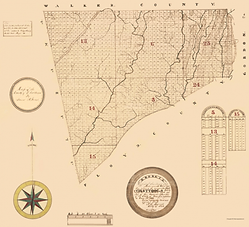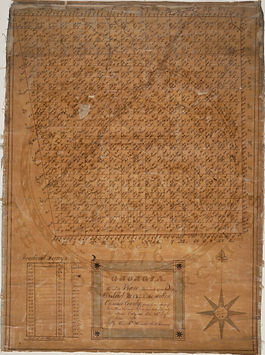
Mineral Rights

Though The New England Improvement Company started as a mining company today it is right the opposit. It now has a goal of conservation of our areas wild and beautiful places. Its rights will never again be leased nor sold. The earth will not be turned and raped of its beauty.
While the North Georgia and North Alabama area is full of minerials and natural gas we feel they are best where they are. Untouched and unclaimed. Any type of mining or drilling has negative affects on the enviroment and the beauty of home.
What are Mineral Rights?
Mineral rights are exactly what they sound like. The rights and ownership of all the minerals on and under the soil.
During the industrial revolution mining companies would come into rural areas that they felt like could be rich with minerals (predominantly coal and iron ore) and buy the rights to the minerals. While the fee simple owners of the land would retain usage of the property the mineral rights would from that point forward be passed along by a mineral rights deed. In the wrong hands they can cause havoc to the land owner and our pristene wildlands.
Today The New England Improvement Company buys mineral rights or has them gifted to it to forever preserve our wilderness land. With holdings now of near 100,000 acres of mineral rights its one of the largest holders in the country.
Land Lots


Before you can understand the deeds that severe the mineral rights from surface use rights you have to understand Land Lots. All of the North Georgia lands were distributed to settlers to encourage people to come into the rural areas and settle. This happened for our area in response to the gold rush in Dahlonega Georgia. Politicians realized that a young country like ours needed those resourses to boost the economy.
To get people into these lands they performed one of the greatest injustices imaginable. In 1831 the US Government forced the Cherokee indians to leave the lands and relocate to Oklahoma. Thousands lost not only their native lands but also their lives on the journey.
Once gone, the US goverment issued two acts to cause the land to be awarded to settelers via a Land Lottery. It means just like what it sounds. White settlers were allowed to put their names in a hat and if drawn would be given a "Lot" of land in North Georgia.
These lotteries were unique to the state; no other state used a lottery system to distribute land. Lot size varied widely, even in the individual lotteries. The largest lots distributed were 490 acres in the 1805 and the 1820 land lottery. The smallest lots were the 40-acre gold lots distributed during the Gold Lottery of 1832.
The Cherokee nation was divided, by the 1832 lottery, into 4 sections and each section divided into districts. Many people, including the state of Georgia, combine the Land Lottery of 1832 and the Gold Lottery of 1832 and represent it as a single lottery; however, both the enabling legislation and the drawings themselves were independent, hence there were seven lotteries, not six.
Prior to 1803 Georgia distributed land via a headright system. Designed to prohibit corruption, the system actually encouraged it. During early administrations the government abused this system and created what today is generally known as the Yazoo Land Fraud. These abuses led to the adoption of the lottery system in May, 1803 under governor John Milledge. The first lottery under the new system occurred in 1805.
Almost 3/4 of the land in present-day Georgia was distributed under this lottery system. During the 27 years that land was distributed under the system the rules and the methods of the lottery remained virtually unchanged.
Applicants could be white males over 18 (or 21 depending on the lottery), orphans, or widows. Fees depended on the lottery and the size of the lot won, but in general they only covered the cost of running the lottery. The state did not profit from allocating these lands.
Fractional lots were sold in each of the lotteries and some lands, especially those near major rivers, was exempt from the lottery. These were distributed by the state using alternate, frequently corrupt, methods
For each person subscribing to a lottery a ticket was placed in the barrel. Since each lottery was over-subscribed, blank tickets were added to compensate for the over-subscription. According to the state archives, no record remains of the people who drew the blank tickets after the 1805 lottery.
Eight times between 1805 and 1833 Georgia held lotteries to distribute land, the largest held in the United States. The lotteries followed a simple pattern:
-
The General Assembly passed an act that authorized the lottery and spelled out who would be eligible to participate and the grant fees that would apply.
-
Eligible citizens registered their names in their county of residence and paid a small fee. The names were sent to the governor’s office at the state capital. Beginning with the second lottery the names were copied onto slips of paper called “tickets” and placed in a large drum called a “wheel.”
-
The land to be distributed was surveyed and laid out in districts and lots. The surveyors sent the district and lot numbers to the governor’s office. These were placed in a separate wheel. (At first, blank tickets were added to this wheel, so that the number of tickets would equal the number of persons drawing.)
-
Commissioners appointed by the governor drew a name ticket from one wheel and a district/lot ticket from the other wheel. If the district/lot ticket was blank, the person received nothing. If the ticket contained a district/lot number, the person received a prize of that parcel of land. A ticket that contained a number was called a “Fortunate Draw.” With later lotteries (after 1820), when blank tickets were not added to the prize wheel, individuals whose names remained in the second wheel were considered to have drawn blanks.
-
Anyone who received a Fortunate Draw could take out a grant for the lot he drew, after paying the grant fee. If he did not take out a grant, the lot reverted back to the state to be sold to the highest bidder.
-
A participant’s registration information was not changed at any time during the land lottery process, and grants, even those issued ten years after the land lottery, include the fortunate drawer’s location during the registration period, not their residence on the date of the grant.” He was obviously speaking of the 1805 lottery but I imagine the same protocol was followed for all of them.
There were slight differnces in all the lotterys but the one that concerns North Georgia is the 1832 lottery. So we will keep our focus there. These where the rules of distribution and "draw" numbers.
1832 Georgia Land Lottery
-
Authority: Act of December 21, 1830; Act of December 24, 1831
-
Registration: Registration for these lotteries was to occur within four months of the Governor’s proclamation of February 20, 1832… The fractional land lots (those less than standard size) were given away in a special lottery in 1833 that used the losing tickets from the 1832 land lotteries
-
Year of Drawing: 1832
-
Counties: The original Cherokee Indian territory became Cherokee County by an Act of December 26, 1831. A law passed on December 3, 1832, divided original Cherokee County into ten counties: Cass (renamed Bartow), Cherokee, Cobb, Floyd, Forsyth, Gilmer, Lumpkin, Murray, Paulding, and Union. In the drawing of tickets and in the granting of the land, the area was treated only as Cherokee territory. It was divided between land lots distributed by the sixth land lottery and “gold” lots that were distributed by the seventh land lottery.
-
Sections and Land Districts: The territory was so expansive that Cherokee County was divided into four sections, and each section was divided into districts. There were a total of 60 land districts, and each was divided into land lots. Fractional lots of 100 acres and more were counted as whole lots.
-
First Section: Districts 6-10, 16-19.
-
Second Section: Districts 4-14, 20, 22-27
-
Third Section: Districts 5-16
-
Fourth Section: Districts 4-15, 18-19
-
-
Size of Land Lots: 160 acres
-
Grant Fee: $18.00 per Land Lot
-
Person Entitled to Draw
-
Married man with wife and/or minor son under 18 and/or unmarried daughter, 3-year residence in Georgia, citizen of United States – 2 draws
-
Widow, 3-year residence in Georgia – 1 draw
-
Wife and/or child, 3-year residence in Georgia, of husband and/or father absent from state for 3 years – 1 draw
-
Family (one or two) of orphans under 18 years, residence since birth in state – 1 draw
-
Family (three or more) of orphans under 18 years, residence since birth in state – 2 draws
-
Widow, husband killed or died in Revolutionary War, War of 1812, or Indian Wars, 3-year residence in Georgia – 2 draws
-
Orphan, father killed in Revolutionary War, War of 1812, or Indian War – 2 draws
-
Wounded or disabled veteran of War of 1812 or Indian Wars, unable to work – 2 draws
-
Veteran of Revolutionary War – 2 draws
-
Veteran of Revolutionary War who had been a fortunate drawer in any previous lottery – 1 draw
-
Child or children of a convict, 3-year residence in Georgia – 1 draw
-
Male idiots, lunatics or insane, deaf and dumb, or blind, over 10 years and under 18 years, 3-year residence in Georgia – 1 draw
-
Female idiots, insane or lunatics or deaf and dumb or blind, over 10 years, 3-year residence in Georgia – 1 draw
-
Family (one or two) of illegitimates under 18 years, residence since birth in Georgia – 1 draw
-
Family (three or more) of illegitimates under 18 years, residence since birth in Georgia – 2 draws
-
Bachelor, 18 years or over, 3-year residence in Georgia, citizen of the United States – 1 draw
-
-
Persons Excluded
-
Any fortunate drawer in any previous land lottery who has taken out a grant of said land lot.
-
Any person who mined—or caused to be mined—gold, silver, or other metal in the Cherokee territory since June 1, 1830.
-
Any person who has taken up residence in Cherokee territory.
-
Any person who is a member of or concerned with “a horde of Thieves known as the Pony Club.”
-
Any person who at any time was convicted of a felony in any court in Georgia.
-
If you are interested in seeing the original land lot maps you can find them here
Don't Forget Chattooga didn't exist (See Cherokee Section 4 District 13)